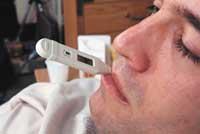Fever: Are there reasons to worry?
Fever is a defense mechanism that helps us “fight” against an invading external (micro) organism. And if it is not very high, it is not necessary to take special measures against it, it is enough not to try to raise more. However, in case of fever it is advisable to always advise the doctor since the disease that produces it may require treatment.
Why do we have a fever?
Fever is one of the components of the complex defense mechanism of our body. Your mission is to fight the enemy and report it.
Natural thermostat
In the brain, and specifically in the hypothalamus, we have a kind of thermostat that regulates body temperature. When the body suffers an attack, like a virus, this mechanism secretes substances that raise body temperature.
What does fever tell us?

The main cause of fever is infections, virus infections, or bacteria, but fever can also occur in other situations, such as inflammatory diseases, tumors, or thyroid imbalances. Women may suffer a slight increase in temperature during the ovulation season (so measuring basal temperature is a very useful method to know on which day a woman may become pregnant).
When do we have a fever?
The human body is not a clock, so it is not so easy to decide when we have a fever, that is, when we have a temperature higher than necessary. However, some general values or references may help us.
Normal temperature
The normal body temperature is about 36.5°C. It must be taken into account, however, that each person has his own body temperature and that at the same temperature may have a few tenths of febrile and another not.
When can you say it is fever?
They are usually called fever at values higher than 38ºC. The values of 37ºC to 37.9ºC are called febrile or flash point, that is, although apparently the temperature is slightly increased, it is not considered febrile.
When to take temperature?
The best time is in the morning, just get up. This is when the most reliable values are produced. And if we take it at any other time of the day, we should try not to do it after eating or dining, or after a major physical effort, since in both cases the temperature can increase considerably. It is normal that the values rise a little in the afternoon.
How should we act in the face of fever?
It is not always necessary to act against fever. Only when the values are very high will we have to take measures to reduce the temperature.
When is it necessary to lower the fever?
If the adult person in good health is not necessary to act against fever, unless it passes 39ºC or 40ºC. It is enough to look at the patient's well-being: it is not necessary to cope with clothes and, moreover, it is necessary to eat fast and especially drink a lot of liquid. In addition to high fever, chills, headaches, itching when urinating, etc. If it appears, you should tell the doctor to decide.
Risk of fever
When the fever is high or lasts too long it can have harmful effects. Fever increases heart rate and can lead to dehydration, especially in young children, the elderly, and people with decreased immune systems. Some children with high fever may have neurological problems, such as seizures. However, it is a symptom to inform the doctor.
What about medicines? Rabies or antibiotics?
When fever is high (or high), special fever medications can always be used: aspirin (acetylsalicylic acid), acetaminophen, or nonsteroidal anti-inflammatory drugs. Antibiotics are only useful in bacterial infections (pneumonia, cystitis) and should always be taken on prescription. If the infection is caused by a virus like the flu, antibiotics are not needed. In this case, the flu itself will destroy germs.
How to measure temperature?
- Clean the thermometer with alcohol or soap and water.
- If it is a thermometer with mercury, check that it is below 35ºC. If not, take it on the opposite side of the mercury drop and shake it well until the temperature drops.
- The thermometer can be placed on the arm, groin, mouth, or anus. These last two areas provide the most accurate temperature, but in the mouth marks half degree more and in the gluteus almost the entire degree more than in the arm or groin.
- The thermometer should be kept between 1 and 2 minutes in the mouth and ass, and between 3 and 4 minutes on the back and groin. In case of fever it is advisable to remeasure the temperature between 3 and 4 hours.
What to do when children have a fever? Fever rises very easily to children because their ‘natural thermostat’ is not yet fully regulated. And although it's just a symptom, you have to take special care of fever in children to avoid risks.
|
Buletina
Bidali zure helbide elektronikoa eta jaso asteroko buletina zure sarrera-ontzian











